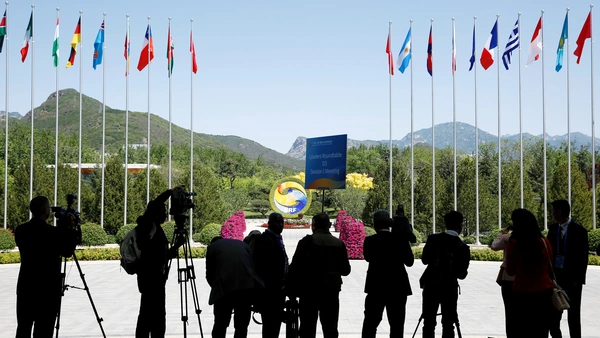by Alyssa Ayres
 Journalists take pictures outside the venue of a summit at the Belt and Road Forum in Beijing, China, May 15, 2017. (Thomas Peter/Reuters)
Journalists take pictures outside the venue of a summit at the Belt and Road Forum in Beijing, China, May 15, 2017. (Thomas Peter/Reuters)
The grandiose Belt and Road Forum—a symbol of China’s foreign policy stepping-out as a global connectivity visionary—kicked off on May 14 with a notable absentee: India.
On May 13, India’s Ministry of External Affairs released its formal response to a question about Indian representation at the Belt and Road Forum, attended by “nearly three dozen” heads of state and dozens of senior officials from around the world. It’s worth reading in full.
The statement abandons the typical language Indian officialdom crafts to be as inoffensive as possible to the greatest number of countries. Citing India’s commitment to physical connectivity “in an equitable and balanced manner,” the statement itemizes a series of principles for infrastructure projects that sound like a World Bank investment monitoring report: “must be based on universally recognized international norms, good governance, rule of law, openness, transparency and equality” “must follow principles of financial responsibility to avoid projects that would create unsustainable debt burden for communities”“balanced ecological and environmental protection and preservation standards” “transparent assessment of project costs” “skill and technology transfer to help long term running and maintenance of the assets created by local communities” “must be pursued in a manner that respects sovereignty and territorial integrity” India obviously believes that Belt and Road projects do not meet the above criteria.
 India’s statement also closes with a kicker focused on the China-Pakistan Economic Corridor (CPEC): “No country can accept a project that ignores its core concerns on sovereignty and territorial integrity.”
India’s statement also closes with a kicker focused on the China-Pakistan Economic Corridor (CPEC): “No country can accept a project that ignores its core concerns on sovereignty and territorial integrity.”
A container is loaded on to the first Chinese container ship to depart after the inauguration of the China Pakistan Economic Corridor port in Gwadar, Pakistan November 13, 2016. (Caren Firouz/Reuters)
India’s objections to CPEC have been repeated and vocal. The crux of the issue concerns the transit pathway that will link western China to the plains of Pakistan and then through to a new deep-water port at Gwadar. The only way to get from western China to the heart of Pakistan is through the Karakoram Highway, a high-altitude transport corridor that in many ways could be called the twentieth-century blueprint for the Belt and Road Initiative. The highway was built by China and Pakistan, beginning back in 1959. It opened in 1979.
The highway runs through territory now called Gilgit-Baltistan (earlier termed the “Northern Areas”) that was originally part of the princely state of Jammu and Kashmir. India and Pakistan both claim the entirety of the former princely state of Jammu and Kashmir, though it is Pakistan’s claims to the Srinagar Valley that tend to occupy international public attention as the “Kashmir Conflict,” not Indian claims to other parts of the territory which Pakistan presently administers. (The history of this territory is complex; for historical details, see Cabeiri deBergh Robinson’s recent book.)
This territory and its history explain the objection to CPEC, but India’s public statement also noted concern for “financial responsibility to avoid projects that would create unsustainable debt burden for communities.”
Here, too, the China-sponsored infrastructure developments in neighboring Sri Lanka offer an instructive lesson. Numerous infrastructure projects, negotiated in secret by the former Sri Lankan government of Mahinda Rajapaksa, saddled the Sri Lankan treasury with debts to China estimated at some $8 billion. Sri Lanka cannot repay what it owes, so it has negotiated a debt-for-equity swap of the Hambantota Port project. This has led to protests in the country.
With other projects financed by China proliferating, under unclear terms and with the prospect of similar bills due down the line, India’s external affairs ministry has a good point. China’s Belt and Road Initiative is not a gift to the world. It is a vision that has a price tag—known to Beijing. That lesson is worth remembering.
But whatever the merit in India’s view, the global response to the forum shows that it has few takers for the moment.
This post originally appeared on Forbes.com.
No comments:
Post a Comment